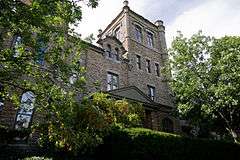Sacred Heart Academy (Cincinnati, Ohio)
|
Sacred Heart Academy | |
|
Tower at the academy | |
  | |
| Location | 525 Lafayette St., Cincinnati, Ohio |
|---|---|
| Coordinates | 39°9′11″N 84°31′38″W / 39.15306°N 84.52722°WCoordinates: 39°9′11″N 84°31′38″W / 39.15306°N 84.52722°W |
| Area | 3 acres (1.2 ha) |
| Built | 1868 |
| Architect | Samuel Hannaford |
| Architectural style | English medieval castle |
| MPS | Samuel Hannaford and Sons TR in Hamilton County |
| NRHP Reference # | 73001467[1] |
| Added to NRHP | April 11, 1973 |
Sacred Heart Academy is a historic former residence and school in the city of Cincinnati, Ohio, United States. Built as the home of a wealthy man, it was the location of a Catholic school for most of its history. As a work of a regionally prominent architect, it has been named a historic site.
History
English immigrant Samuel Hannaford began his Cincinnati architectural practice in 1858 in partnership with Edwin Anderson. This partnership endured until 1870,[2]:10 shortly after Sacred Heart Academy was constructed in 1868.[1] The building was originally a massive house; its first resident, William C. Neff, desired that his home be patterned after the English Kenilworth Castle.[3] Neff's house was one of numerous residences that Hannaford designed for Cincinnati's wealthy, although it predates most others; Hannaford became prominent in Cincinnati and the surrounding region only after designing Music Hall near downtown in 1877,[2]:11 and the Gilded Age at the end of the nineteenth century saw numerous Hannaford houses being constructed in prestigious neighborhoods such as Walnut Hills and Avondale.[2]:10 Neff only lived in his great house for a few years; in 1876, it was acquired by the Academy of the Sacred Heart, which needed to leave its previous location on Grandin Road. The Academy used the property for nearly a century until closing entirely in 1970,[3] but it had remained active among Catholic schools until shortly before the end; in the late 1960s, it became a founding member of the Girls Greater Cincinnati League.[4] During its decades in the building, the school arranged for the construction of multiple additions to the original structure.[3]
Architecture
Built primarily of stone,[1] the Academy features ashlar walls with a rough appearance. Most parts of the building are two or three stories tall, although the intended English castle appearance is responsible for the presence of a four-story tower. Visitors enter through a portico dominated by pointed arches: both the main entrance and the sidelights employ the design, as does a window placed under the main part of the tower.[3] Such windows, emblematic of the Gothic Revival style, were also used for later construction; they form a crucial component of an attached chapel built during the school's occupation of the building.[2]:9 Inside, hand-carven wood panelling is exceptionally extensive: the Swiss woodworkers whom Neff hired for the purpose required two full years of work to complete the carvings.[3]
Historic site
In 1973, the academy was listed on the National Register of Historic Places, qualifying because of its historically significant architecture. Seven years later, it was included in a multiple property submission of fifty-five Hannaford-designed buildings in Hamilton County;[1] its previous National Register status, along with that of sixteen others in the submission, was a significant component of the rationale for granting National Register status to the remaining thirty-eight buildings.[2]:12
References
- 1 2 3 4 National Park Service (2010-07-09). "National Register Information System". National Register of Historic Places. National Park Service.
- 1 2 3 4 5 Gordon, Stephen C., and Elisabeth H. Tuttle. National Register of Historic Places Inventory/Nomination: Samuel Hannaford & Sons Thematic Resources. National Park Service, 1978-12-11.
- 1 2 3 4 5 Owen, Lorrie K., ed. Dictionary of Ohio Historic Places. Vol. 2. St. Clair Shores: Somerset, 1999, 663-664.
- ↑ History, Girls Greater Cincinnati League, 2008-02-06. Accessed 2014-01-28.
Further reading
- Pender, Linda. "The Castle Guard". Cincinnati Magazine 24.10 (1991): 50-52.

